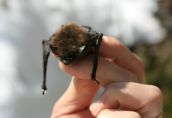
Study: Toxic pollutants found in eggs of Maine birds
Portland Press Herald – pressherald.mainetoday.com
11 Mar 2008
J Richardson
Location: Maine, USA
Photo courtesy of Portland Press Herald
Even in northern Maine, wild eggs have traces of numerous chemicals.
The eggs of birds across the state, from bald eagles and loons in northern Maine to ospreys on the South Portland waterfront, contain a soup of industrial chemicals, according to a study to be presented in the Legislature today.
The Gorham-based BioDiversity Research Institute tested eggs from 23 different kinds of birds and looked for more than 100 toxic pollutants, including pesticides, mercury and carpet-stain repellents. It's the first study anywhere to provide such a broad snapshot of toxic contaminants in the food chain, said Wing Goodale, the lead researcher.
"We found all the major contaminants we looked for in every species, in every habitat," Goodale said. "We found all of the compounds in the wild, and we found many of them above levels that research has established can cause effects."
 Disease claims Nev. bighorn sheep herd
Disease claims Nev. bighorn sheep herdNBC News 4 – www.krnv.com (Source: Associated Press)
13 Mar 2008
Location: Hays Canyon Range, Nevada
Photo courtesy of NBC News 4
A disease outbreak has decimated, if not destroyed, a herd of California bighorn sheep in northwest Nevada.
A biologist and veterinarian with the Nevada Department of Wildlife say it's questionable whether any of the estimated 110 bighorns in the Hays Canyon Range northwest of Gerlach survived.
The first hint of trouble came in August 2005, when "one coughing and one sneezing" bighorn sheep were observed.
Last October, a hunter reported seeing a sick ewe that was found dead a few hours later.
Game wardens retrieved the carcass for testing, which confirmed the ewe had died of bacterial pneumonia.
Rabies Cases Reach Record High In Virginia
All Headline News – www.allheadlinenews.com
11 Mar 2008
N Sharma
Location: Virginia, USA
As the National Rabies Awareness Week begins in Virginia, the Department of Health reported on Monday that 2007 saw the highest number of rabies cases in more than 20 years.
In 2007, 730 cases of the disease were reported in animals in Virginia, the highest since 1982, when the Health Department received 745 reports. The most common animals to be diagnosed with rabies are raccoons, followed by skunks, and then foxes.
OTHER WILDLIFE HEALTH RELATED NEWS
Photo courtesy of Vermont Public Radio
 Mysterious Disease Kills Bats in the Northeast [Audio broadcast includes slideshow]
Mysterious Disease Kills Bats in the Northeast [Audio broadcast includes slideshow]- Wyoming Concludes 2007 CWD Testing
- ProMed-mail - West Nile virus update 2008 - Western Hemisphere (01)
- Mechanism of influenza transmission [Video clips]
- Bat Found In North Little Rock Tests Positive For Rabies
- Fish disease study grant awarded
- Game and Fish tackle antelope, elk studies
- Catch and release: Indiana's mercury may be in your fish
WILDLIFE HEALTH RELATED PUBLICATIONS
Chronic Wasting Disease Update - Report No. 90a
10 Mar 2008
Realtime RT-PCR Assay Unable to Detect H7 Subtype Avian Influenza Viruses Isolated from Wild Birds
J Clin Microbiol. 2008 Mar 5 [Epub ahead of print][online abstract only]
Z Xing et al.
Highly Pathogenic Avian Influenza Virus (H5N1) in Domestic Poultry and Relationship with Migratory Birds, South Korea
Emerg Infect Dis. 2008 Mar;14(3):487-490. {free full-text available]
YJ Lee et al.
Emerging Infectious Diseases - March 2008
Volume 14, Issue 3





No comments:
Post a Comment